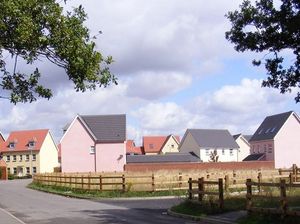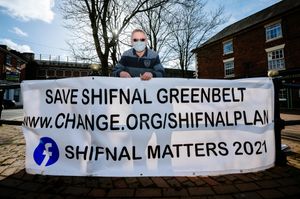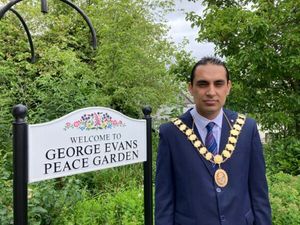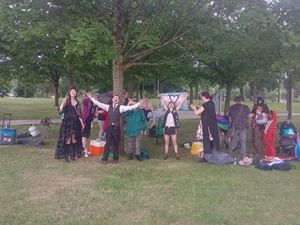Shropshire's green belt at risk, says new report
The threat to Shropshire’s open space was highlighted today as a new report revealed a huge rise in house building plans on green belt land.

Campaigners in Shifnal have backed a report from the Campaign to Protect Rural England, which reveals a five-fold rise in housing schemes on protected land in the past eight years.
The CPRE says precious green spaces around towns across Shropshire are at risk. Its State of the Green Belt report comes the day before the consultation deadline for Shropshire Council’s draft local plan, which sets out where 30,800 houses and 740 acres of employment land are to be built across the county in the next 17 years.
Charles Green, of Shropshire CPRE, said the plan over-estimated the need for housing growth. He said he was also concerned about plans to take land out of the green belt to ‘safeguard’ land for possible future development beyond the 17-year term of the current plan.
“The green belt has a number of important functions, not only to stop the spread of urban sprawl, but also to support urban regeneration, by encouraging the use of brownfield sites,” he said.
The draft plan, agreed by Shropshire Council’s cabinet in December, would also see 1,000 homes and 74 acres of business space to cater for overspill from the Association of Black Country Authorities. It sets Shifnal a target of 1,500 new homes and 100 acres of business land to be developed by 2038. A petition, supported by 2,238 people objecting to the plan, has been presented to the council.
John Moore, of the Shifnal Matters pressure group, said he was extremely concerned about proposals to allow houses to be built on Lodge Hill in the town.
Mr Moore accused Shropshire Council of turning Shifnal into a commuter town for the West Midlands conurbation.
“The green belt is being offered as a takeaway for the Association of Black Country Authorities,” he said.
Councillor Robert Macey, Shropshire Council’s portfolio holder for housing and strategic planning, said: “The council will follow agreed procedures in responding to the petition and this will include giving this consideration, along with all other representations made, as we continue to progress the local plan this year.”
Fighting to maintain our green and pleasant land

John Moore reckons you can’t beat the view from the top of Lodge Hill.
“You can see in all directions, down across Wesley Brook, all the way towards Telford,” he says.
“It’s a great vantage point, and for generations it’s been the place that people go to for tobogganing in the winter.”
But Mr Moore fears the views he cherishes are under threat from Shropshire Council’s plans for 1,823 new homes in the Shifnal area. He accuses the local authority of treating the green belt like a ‘takeaway’ for neighbouring areas snapping up the prime land for commuter housing.
He is not alone. A report published today by the Campaign for the Protection of Rural England (CPRE) warns that a quarter of a million homes are set to be built on land which has been removed from the green belt. The charity says local authority plans for housing on the English green belt have more than quadrupled in the past eight years.
The CPRE’s annual State of Greenbelt report reveals there are currently 257,944 homes proposed to be built on land removed from the green belt, a 475 per cent increase on the figure for 2013. And with only one in 10 of these homes considered affordable, the charity says it will do little to tackle the shortage of housing for young people trying get a foothold on the property ladder.
CPRE chief executive, Crispin Truman, says this is not only disastrous for the environment, it flies in the face of public opinion. He says a new poll, conducted by Opinium on behalf of CPRE, shows a surge in appreciation for local green spaces since the first lockdown, much of which are located in the green belt.
Priority
The poll says more than two-thirds of those questioned think protecting and enhancing green spaces should be a higher priority after lockdown.
It also says that 46 per cent are visiting green spaces more frequently since the start of lockdown, while 59 per cent say they are more aware of the importance of green spaces for our mental health and wellbeing.
“Local countryside and green spaces have been a lifeline through lockdown,” says Mr Truman. “Our poll shows massive public support for protecting these places, their importance for our mental health and wellbeing is undeniable. So, to see the growing level of threat faced by the green belt, the countryside next door for millions of people living in our towns and cities, is extremely worrying.”
The CPRE warns that this pressure is only set to increase under changes to the planning system being considered by the Government. The charity claims that a proposed new formula to determine housing supply could lead to an increase in housing on the green belt of at least 35 per cent.
The big bone of contention is the Government’s target of seeing 300,000 new homes built each year to meet housing needs. Housing, Communities and Local Government Secretary Robert Jenrick published a White Paper entitled Planning for the Future in October last year, which aims to streamline the planning process in order to ease the national housing shortage. Its stated aims are not controversial: to ease the housing shortage and boost the post-Covid economy by removing red tape which makes it difficult for developers to build new homes.
Barrier
Mr Jenrick says the complicated planning system is a barrier to building the homes people need.
“It takes seven years to agree local housing plans and five years just to get a spade in the ground,” he says. “These once-in-a generation-reforms will lay the foundations for a brighter future, providing more homes for young people and creating better quality neighbourhoods and homes across the country.”
Mr Jenrick says local housing plans, which are drawn up by local authorities to decide which areas are considered suitable for development, should be completed within 30 months rather than the present seven years.
It also proposes carving areas up into three different categories, ‘growth’, ‘renewal’ and ‘protected’, with a fast-track planning regimes for the ‘growth’ and ‘renewal’ areas.
“Planning decisions will be simple and transparent, with local democracy at the heart of the process” says Mr Jenrick. He says they will also create thousands of jobs, and make it easier for small building companies, without the resources to challenge the planning authorities, to compete with the larger companies.
Unconvinced
The CPRE is unconvinced, fearing the changes will simply make the planning system less accountable. It is particularly worried about the relaxation of planning regulation ‘growth’ areas, which are likely to include greenfield areas on the edge of major towns or cities – just like the rural fringes between Wolverhampton and Shifnal.
The charity argues that the biggest obstacle to the Government meeting its target of 300,000 homes a year is not a shortage of sites where permission has been granted, but rather developers deliberately sitting on these sites to control supply and thus inflate house prices.
It also points out that of the developments planned for green belt land between 2015 and 2020, only 10 per cent were for what is deemed ‘affordable housing’.
“On this trajectory, we risk losing ever more green belt while having no impact on the housing crisis and providing homes local communities are able to afford,” the CPRE warns.
Mr Truman says existing planning laws provide vital protection to green spaces, and the focus should be on providing more incentive to redevelop brownfield sites.
“The Government can and must act to stop the loss of green belt and ensure greater access to nature and green space is at the heart of our planning system,” he says.
“This can be done by making best use of land that’s been built on previously before even considering development on the green belt.
“The public is crying out for more access to nature, green space and countryside – it’s time ministers realised this and put people and nature at the heart of their changes to the planning system.”





